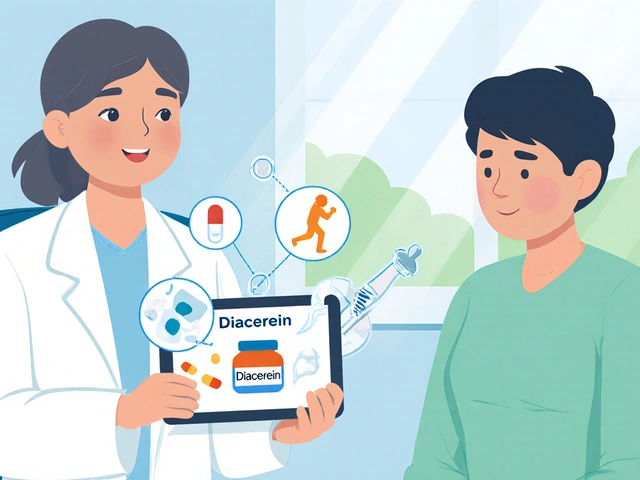In the quest to prevent ulcers, especially those caused by NSAIDs, exploring alternatives to Cytotec is crucial for many. In 2024, we've seen a variety of effective options that address stomach acid in innovative ways. These alternatives range from medications like Omeprazole and Famotidine to lesser-known options such as Sucralfate. Each has its unique mode of action, benefits, and potential drawbacks. Understanding these options can make a significant difference in treatment outcomes and patient comfort.
Omeprazole
Omeprazole, a renowned medication in the realm of proton pump inhibitors (PPIs), offers a robust solution for reducing stomach acid production, a crucial step in ulcer prevention and treatment. By blocking the enzyme in the stomach lining responsible for acid secretion, Omeprazole effectively supports the management of conditions caused by excessive stomach acid, such as gastroesophageal reflux disease (GERD) and peptic ulcer disease. Introduced in the late 1980s, it has since gained widespread recognition and is often preferred for its efficacy and tolerance profile. Available in both prescription and over-the-counter forms, it provides flexible options catering to varying patient needs and schedules.
Omeprazole not only shows phenomenal results in reducing acid secretion but also boasts several versatile formulations, including tablets, capsules, and oral suspensions. This versatility is beneficial for patients who might have difficulty swallowing pills or require tailored dosing. While it generally maintains a positive tolerance profile, common side effects include headaches, diarrhea, and abdominal pain, which are largely well-tolerated and resolvable. However, long-term use raises concerns of potential side effects such as an increased risk of osteoporosis-related injuries, necessitating a balanced and cautious approach to its prolonged usage. A comprehensive understanding of these implications is imperative for both patients and healthcare providers.
"Omeprazole significantly reduces gastric acid secretion and is often a first-line treatment in managing acid-related disorders,” explains Dr. William Jones, a well-respected gastroenterologist at Healthline.
In clinical settings, studies have demonstrated Omeprazole’s effectiveness when compared to other PPIs, suggesting it provides a potent and relatively rapid acid control within days of administration. Given the array of medications available, Omeprazole's cost-effectiveness plays a substantial role in its selection, especially when budgetary considerations are pivotal without sacrificing therapeutic outcomes. Besides, it remains a valuable alternative to individuals intolerant to other PPIs, making it an integral part of therapeutic regimens for reducing gastric acid. These qualities collectively underscore the importance of Omeprazole in treating conditions ranging from simple heartburn to more complex ulcerations caused by NSAIDs.
Pros
- Effects onset within twenty-four hours, providing noticeable symptom relief.
- Multiple available formulations allow customizable patient care.
- Well-tolerated, with minor side effects that typically resolve quickly.
Cons
- Prolonged use may lead to increased fracture risks due to bone density impact.
- May require tapering dosage under medical supervision to mitigate withdrawal symptoms.
- Chronic use could result in vitamin B12 deficiencies, necessitating regular health checks.
In summary, Omeprazole remains a cornerstone medication within the framework of modern ulcer and gastric acid treatments. Understanding its functions, benefits, and potential drawbacks allows patients and healthcare providers to make informed decisions tailored to individual circumstances. This ensures that both immediate needs for symptom relief and long-term health considerations are harmoniously balanced.
Famotidine
Famotidine stands out as a distinguished H2 receptor antagonist, lauded for its effectiveness in reducing stomach acid and preventing ulcers caused by the use of NSAIDs. By directly blocking histamine receptors in the stomach lining, it significantly curtails acid production, thus alleviating conditions like gastroesophageal reflux disease (GERD) and maintaining balance in individuals vulnerable to peptic ulcers. This drug has gained popularity due to its quick onset of action, making it a favored choice for those seeking prompt relief from gastric discomforts.Famotidine is less likely to cause diarrhea compared to proton pump inhibitors (PPIs), positioning it as a suitable option for those struggling with side effects associated with other acid-reducing medications. Available in numerous formulations, including over-the-counter versions, it offers accessible relief for diverse patient needs. Many appreciate the ability to address digestive issues without a prescriptive hassle—a convenience in today's fast-paced world.
Even so, Famotidine isn't without its disadvantages. As with any medication, patients need to be cautious of potential side effects, such as headaches, dizziness, and constipation. Its quick action is offset by being less effective than PPIs in some severe cases. It's crucial for patients to weigh these factors before starting treatment. However, what sets Famotidine apart is its ability to provide a balance between efficacy and safety, steering away from the long-term pitfalls linked to PPIs, like increased osteoporosis risk. It's a topic of ongoing research, with many studies examining its long-term impact and effectiveness compared to other treatments.
Famotidine's efficacy in tackling digestive problems has piqued interest across multiple health sectors. A resurgence in its utilization can be attributed to these benefits. Yet, one should consult healthcare providers to ensure compatibility with other medications. In a community discussion on Healthline, a noted gastroenterologist commented, "Famotidine's reemergence in treating acid-related disorders highlights its therapeutic value, especially for those experiencing intolerance to PPIs." This attests to the medication's restored relevance in certain treatment plans. Understanding these nuances aids in making informed health choices when dealing with stomach acid challenges.

Pantoprazole
When it comes to battling stomach acidity and preventing ulcers, Pantoprazole has established itself as a formidable contender in the world of proton pump inhibitors (PPIs). Known for its effective action against gastric acid secretion, Pantoprazole works by selectively blocking an enzyme present in the gastric lining, thereby reducing the overall production of acid. This mechanism not only provides relief from symptoms associated with high stomach acid but also plays a crucial role in healing and preventing ulcers. Patients often prefer Pantoprazole due to its well-tolerated nature, which makes it a go-to choice in the clinical settings of 2024.
The medication comes in several formulations, allowing for flexibility depending on patient needs and specific treatment plans. Available both as an oral tablet and an intravenous infusion, Pantoprazole ensures that those who cannot take medications orally, due to conditions like vomiting or esophageal strictures, can still receive treatment. Its diverse application reflects its adaptability, which has significantly increased its use. Notably, Pantoprazole isn't merely overshadowed by its ability to treat and manage gastroesophageal reflux disease (GERD) but is also instrumental in addressing conditions such as Zollinger-Ellison syndrome, where gastric acid is produced in excess.
Proton pump inhibitors like Pantoprazole are often compared to H2 antagonists like Famotidine, with studies indicating their superior efficacy in increasing the pH level of stomach acid, hence lessening the chances of acid-related damage. One interesting statistic, brought forward by the Global Digestive Health Foundation, highlights that PPIs are nearly 40% more effective in controlling gastric acid secretion long-term compared to H2 blockers. Despite its advantages, Pantoprazole is not without its cons, as prolonged usage has been linked to potential side effects such as headaches, diarrhea, and in rare long-term cases, an increased risk of osteoporosis and fractures.
Pantoprazole's incorporation into daily practice is seen as groundbreaking, with a notable gastroenterologist once stating, "The advent of PPIs has revolutionized the way we approach acid-related disorders, providing relief to millions of patients worldwide."
It’s important for patients considering Pantoprazole to engage in a dialogue with their healthcare providers about the intended duration of treatment and any underlying health conditions that might influence its use. Discussions typically center around balancing the benefits of acid reduction with the potential risks linked to extended use, particularly when it comes to bone health. As researchers continue to unravel the complexities of acid-related disorders, Pantoprazole stands as a significant milestone in medical treatment, offering hope and healing where once chronic discomfort reigned.
Lansoprazole
Lansoprazole, a member of the proton pump inhibitor (PPI) family, plays a pivotal role in reducing stomach acid, much like its fellow alternatives, Omeprazole and Pantoprazole. Originally approved for use across several conditions affecting the gastrointestinal system, it is particularly esteemed for its proficiency in treating gastroesophageal reflux disease (GERD) and the prevention of ulcers driven by prolonged NSAID use. By inhibiting an enzyme known as H+/K+ ATPase located in the stomach lining, Lansoprazole effectively decreases the production of gastric acid. Patients often appreciate its rapid action, which provides relief from stomach pain and discomfort relatively quickly, typically showing effects within 24 to 48 hours of administration.
As a versatile medication, Lansoprazole is available in various formulations, including delayed-release capsules and orally disintegrating tablets. Its over-the-counter availability has expanded access, enabling patients to manage mild symptoms without immediate medical consultation. However, like any medication, it requires proper usage guidance to maximize benefits and minimize potential side effects. According to a comprehensive study in the "American Journal of Gastroenterology," Lansoprazole has been shown to significantly lower the frequency and severity of heartburn symptoms, highlighting its strong efficacy in acid reduction.
"Lansoprazole offers a reliable option for patients needing long-term acid suppression, with a commendable safety profile," noted Dr. Helen O'Connor, a leading gastroenterologist, during a recent medical conference.
Its ease of use is complemented by a relatively low incidence of severe adverse effects. Commonly reported side effects include headache, diarrhea, and abdominal pain, which are generally mild and temporary. However, one must be cautious about prolonged usage, as studies have indicated a potential association with an increased risk of osteoporosis and bone fractures. This necessitates a balanced approach to prescribing such medications, where benefits are weighed against long-term risks.
Patients who require uninterrupted NSAID therapy for conditions such as arthritis often find Lansoprazole to be a vital component of their treatment regimen. It allows them to manage their primary condition while minimizing the gastrointestinal complications that could arise from NSAID-induced ulceration. Yet, it emphasizes the importance of following a healthcare provider’s recommendations to tailor therapy to individual needs and mitigate associated risks. Understanding these intricacies can profoundly influence patient adherence and treatment effectiveness.
In today's healthcare landscape, where medication options are manifold, Lansoprazole remains a cornerstone for effective gastric acid regulation and ulcer prevention. Its role in ensuring gastrointestinal health underscores its value to both patients and medical professionals aiming for optimal digestive system function.

Sucralfate: A Unique Approach to Ulcer Prevention
Sucralfate is a fascinating option when it comes to ulcer prevention, working fundamentally differently from other medications. Unlike proton pump inhibitors (PPIs) or H2 receptor antagonists that target the reduction of stomach acid production, Sucralfate creates a protective barrier over the ulcer. This barrier acts like a physical shield, protecting the delicate tissue from the harsh acidic environment within the stomach, and allowing natural healing processes to take place more effectively. This characteristic sets it apart as a unique choice, especially suitable for those unable to tolerate the acid suppression effects of other medications.
One of the significant advantages of Sucralfate is its ability to be used in patients with renal impairment, which is not always possible with other ulcer-preventing drugs that rely heavily on kidney function for excretion. It's relatively inexpensive as well, making it a more accessible option for individuals concerned about the costs associated with long-term medication use. However, using Sucralfate does come with its own set of challenges. It requires multiple daily doses, which might be perceived as inconvenient for those accustomed to once-daily medication. It's not as effective as PPIs or H2 antagonists in preventing ulcers, which could be a drawback for patients requiring robust acid suppression.
Pros
- Does not affect acid production, making it suitable for patients who cannot manage the side effects associated with reduced acid levels.
- Can be used in individuals with renal impairment, providing a viable choice for a broader range of patients.
- Cost-effective, offering a solution for those seeking effective treatment without a significant financial burden.
Cons
- May cause side effects such as constipation, requiring careful management and potentially additional remedies to address this issue.
- Frequent dosing schedules, making adherence to the treatment plan potentially more challenging for patients with busy lifestyles.
- Not as effective as other options in the prevention of ulcers, especially for those with conditions requiring a more aggressive treatment plan.
According to Dr. Maria Gonzalez, a gastroenterologist at the Mayo Clinic, "The choice of ulcer prevention medication should always consider the patient's overall health profile and lifestyle. Sucralfate offers a different mechanism that can be beneficial, particularly for those who cannot handle the effects of acid-reducing drugs."
In 2024, Sucralfate remains a topic of interest not just because of its function, but also due to its resilience in the market despite being overshadowed by more aggressively marketed drugs. It serves a specific niche and continues to find favor among clinicians valuing its unique protective barrier mechanism. When considering Sucralfate, it's essential to have an open discussion with healthcare providers to weigh its benefits against potential lifestyle inconveniences. This step ensures a tailored approach to treatment and enhances the healing journey by aligning medication choice with patient needs and preferences.
Ranitidine
Ranitidine, once a household name in the realm of ulcer prevention and stomach acid reduction, has an interesting history and role among Cytotec alternatives. As an H2 receptor antagonist, Ranitidine made its mark by effectively curbing the production of gastric acid. It acts by blocking histamine receptors in the stomach, which in turn helps prevent ulcers caused by NSAIDs. This mechanism of action was particularly appealing because of its quick onset, offering relief much faster than many other alternatives available. Its popularity soared not just due to its efficacy, but also because of its accessibility - it was readily available over-the-counter in various formulations during its prominent years.
The primary advantage that Ranitidine had over proton pump inhibitors was its ability to work swiftly, providing quick relief from acid-related symptoms. Patients who experienced troublesome nighttime acid reflux found substantial benefit from using Ranitidine, as it could prevent acid surges effectively. Interestingly, for a long time, Ranitidine was a favorite among physicians looking for a reliable way to manage mild-to-moderate acid reflux without delving into more potent therapies. Another reason Ranitidine appealed to many was its relatively favorable side effect profile; instances of diarrhea were notably less frequent compared to PPIs.
However, Ranitidine was not without its share of controversies and challenges. In recent years, concerns regarding its potential carcinogenic effects emerged, drastically impacting its usage. Studies revealed that Ranitidine could produce a contamination called NDMA, a substance classified as probably carcinogenic to humans. This discovery led to its recall in many countries around the world, as health authorities opted to err on the side of caution. The disappearance of Ranitidine from pharmacy shelves posed a significant dilemma for long-time users who had depended on it for their gastrointestinal health.
According to Dr. Amy Stovsky, a leading gastroenterologist, "The recall of Ranitidine was a significant turning point in the treatment landscape for acid-related disorders. Patients and practitioners both felt the void left by this once-trusted medication."
In light of these issues, exploring other ulcer prevention options became crucial for patients and healthcare providers. Many switched to alternative H2 antagonists or PPIs, though some still hoped for a future where Ranitidine could be reformulated safely. It’s worth noting that despite the recalls, the discussions around effectiveness, safety, and patient preference related to Ranitidine have had a lasting impact on the way we approach gastrointestinal treatments today.
A key consideration for anyone who might wonder about the risks and benefits of Ranitidine is to look at its history as a case in point of drug development and safety monitoring. While its story might serve as a cautionary tale, it also underscores the importance of continuous evaluation and improvement in the realm of NSAID ulcers management.

Conclusion
When considering the myriad options available for ulcer prevention and stomach acid reduction in 2024, it's clear that the medical field has made significant strides since Cytotec first entered the scene. Each alternative offers unique benefits tailored to different needs, with some focusing on rapid action, while others prioritize long-term safety. For instance, PPIs like Omeprazole and Pantoprazole are known for their efficacy in reducing gastric acid secretion, yet users should be cautious of potential long-term risks, such as osteoporosis. These considerations are vital when making a choice for oneself or others.
Choosing an alternative to Cytotec isn't simply a matter of knowing which medication works; it's about understanding how each option fits an individual's specific health profile. Famotidine and Ranitidine, both H2 receptor antagonists, provide quick relief with a lower risk of diarrhea than their PPI counterparts, but effectiveness can vary. There is also an ongoing debate regarding the safety concerns raised about Ranitidine, leading to recalls in some regions. These facets add another layer to decision-making, requiring in-depth consultation with healthcare professionals who are up-to-date with the latest studies and patient outcomes.
A trusted source in gastroenterological research once noted,
"The future of gastric care lies not only in the development of new drugs but in the nuanced understanding of existing treatments and their impact on human health". This insight underscores the importance of keeping an open mind to personalized treatment plans, leveraging existing medications like Lansoprazole and Sucralfate in a way that optimizes their potential benefits while mitigating downsides. The balance between cost, availability, side effects, and pharmaceutical interactions plays a pivotal role in choosing between these alternatives.
To aid in making these critical healthcare decisions, consider the following comparative data:
| Medication | Quick Action | Long-term Profiling | Special Considerations |
|---|---|---|---|
| Omeprazole | No | Increased osteoporosis risk | Over-the-counter availability |
| Famotidine | Yes | Less effective than PPIs | OTC formulations |
| Pantoprazole | No | Fracture risk | Prescription needed for higher doses |
| Lansoprazole | No | Osteoporosis concerns | Available OTC |
| Sucralfate | No | Multisided dosage | Effective in specific scenarios |
| Ranitidine | Yes | Safety queries | Intensity of regulatory scrutiny |
Ultimately, the journey to finding the right alternative to Cytotec requires a careful weighing of factors. By understanding the strengths and weaknesses of each option, individuals can ensure that they, along with their healthcare providers, make informed decisions that best align with their ulcer prevention goals. Such an approach not only encompasses effective medicinal care but empowers patients with knowledge, driving meaningful health outcomes.



 Medications
Medications





Jasmine Hwang
November 22, 2024 AT 10:40lol who even uses cytotec anymore? i just chug tums and call it a day. also ranitidine was fine until the FDA turned into a paranoid aunt with a lawsuit checklist.
liam coughlan
November 22, 2024 AT 22:09Interesting breakdown. I’ve been on famotidine for years-no issues, no weird bone density scares. PPIs just felt like overkill for my mild reflux.
Maeve Marley
November 23, 2024 AT 01:36Okay but let’s be real-sucralfate is the unsung hero here. I had a kidney transplant and every acid med they threw at me made my creatinine spike. Sucralfate? Zero impact on my labs. Sure, I have to take it four times a day and I sound like a broken record to my roommate, but I’d rather be inconvenienced than dialyzed. Also, it’s like $5 at Walmart. No joke, I’ve been using it since 2019 and my ulcers haven’t come back. If you’re on NSAIDs long-term and your kidneys are iffy? This is your friend. Also, the constipation? Just add a spoon of psyllium and you’re golden. Stop overcomplicating things with fancy PPIs unless you’re literally vomiting blood.
James Gonzales-Meisler
November 23, 2024 AT 07:22The article contains multiple grammatical inconsistencies: 'a few
where needed' is not standard HTML usage, and the table header formatting is improperly escaped. Also, 'Cytotec' is misused-it's misoprostol, not a brand name for ulcer prevention. The conclusion conflates 'ulcer prevention' with 'NSAID-induced ulcer prophylaxis,' which are not synonymous. The data table is misleading-omeprazole and lansoprazole *do* have quick onset, just not as fast as H2 blockers. This is sloppy work.
Navin Kumar Ramalingam
November 24, 2024 AT 20:52Look, if you're still using famotidine or sucralfate in 2024, you're basically using 90s tech while the world moved to quantum PPIs. I mean, come on. Omeprazole is the baseline. Everything else is just... compensating. Ranitidine? That's a meme now. Sucralfate? Cute. Like using a candle when you have a Tesla charger. The real question is why anyone would risk chronic B12 deficiency or *gasp* constipation over a $10 generic PPI. You're not saving money-you're saving time on your GI specialist visits.
Shawn Baumgartner
November 25, 2024 AT 15:43Let me break this down for you like you’re five: PPIs are not 'alternatives'-they’re the STANDARD OF CARE. Sucralfate? A topical bandage for a gunshot wound. Famotidine? A placebo with a pulse. Ranitidine? A chemical time bomb wrapped in a 1990s marketing campaign. The fact that this article even lists it without screaming 'CANCER RISK' in 72-point font is criminal negligence. And don’t get me started on the 'OTC availability' nonsense-just because you can buy it at CVS doesn’t mean you should. This isn’t a grocery list, it’s a gastrointestinal minefield. If you’re not on a PPI and you’re on NSAIDs daily, you’re not 'managing' your ulcers-you’re just delaying the inevitable ER visit. The data is clear. The science is settled. Stop playing doctor with your stomach lining.
Cassaundra Pettigrew
November 26, 2024 AT 21:35AMERICA’S GI TRAGEDY: We’re letting Big Pharma brainwash us into thinking PPIs are magic. Meanwhile, the rest of the world-like India, Ireland, even Canada-is using sucralfate like it’s the holy grail. Why? Because it doesn’t destroy your microbiome or turn your bones into dust. And now we got some Silicon Valley bro telling us to 'just take omeprazole' like it’s a vitamin? Nah. This article is a corporate shill. Sucralfate is the real MVP-cheap, safe, and it doesn’t require a PhD to use. The fact that we even have to debate this? That’s the real ulcer. Shame on you, U.S. healthcare.